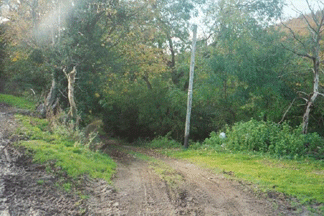Literary garden enigmas

A lane in Shropshire, the setting for Mary Webb's novels
Still on the topic of gardening and reading, as I become more immersed in gardening, I’m correspondingly more curious about flower reference in books—references that I took for granted before. These mysteries arise from the fact that I am a rabid anglophile and a huge fan of early twentieth century novels by British women authors (many published by the Virago imprint). I’ve seen co.uk domains when I check Sitemeter, so maybe some of you Brits can reveal to me:
•What in god’s name are cowslips? You rarely see latin names in these novels, so I have no idea what they correspond to on this side of the Atlantic. In the books, the characters are always gathering cowslips, from which the younger ones make cowslip tea, apparently quite a noxious beverage.
•What type of primrose is so common there? It is an early spring flower and is always pale yellow. Thus, when characters have a primrose-colored ballgown, you always know what color it is. Over here, I see primroses of every color but yellow. Confusing.
•Cow parsley?
•Michaelmas daisies? Could these be asters? Rudbeckia? They seem to emerge in the fall.
•Dog roses?
•What, precisely, is a bluebell wood? A group of trees where scilla grow every spring? That would make sense.
Some of these usages may be archaic, and, of course, certain plants are perennial in England and are not here: hence, more confusion. Of course, there is a certain pleasure in accepting the references as part of the bucolic mise en scène that makes these books so enjoyable.

Comments
Cowslips: I'm pretty sure it's used to make a sedative in a tea form.
English primroses: Hmmm - I always thought they were the same as here.
Cow parsley: Not familiar with this one.
Michaelmas Daisy: Same as New England Aster. Many of North America's native plants were more popular in European gardens before they were popular here (people here thought of them as weeds).
Dog Rose: Pink wild rose native to Europe. AKA in English poetry as Sweet Briar. Hips are used for jams and teas.
Bluebell wood: I would guess a woodland filled with the common British bluebell? Blooms in spring and forms large patches - like the Virginia Bluebell here. I looked online for this one - see a great pictures on Wikipedia here: http://en.wikipedia.org/wiki/Common_Bluebell
Cow parsley may be the same as water parsley? A deadly lookalike to water hemlock?
I'm also a little confused on the dog rose. I could have sworn I read some English book where the heroine picks a bunch of dog roses and then has an allergic reaction. I assumed it was some sort of plant like poison ivy or
poison oak, but with pretty flowers.
Maybe a bluebell wood is carpeted in English bluebells?
Oh - I'm not English either.
You might comment on some English garden blog sites and see if you can get some more help!
Charlotte MacLeod wrote a botanical mystery with her sleuth Peter Shandy that was set in England. It was called 'The attack of the giant Hogweed', and this hogweed was described as a relative to both Cow Parsley and water hemlock.
The Virginia bluebell is Mertensia, a leafy perennial that goes dormant. I miss mine! The English bluebells are bulbs - used to be under Scilla, but they might be under a different genus name now. Charles Elliot in "The Transplanted Gardener" refers to Bluebell woods as 'dense pools of drooping bells blanketing whole stretches of the forest floor' - oh, doesn't that sound lovely?